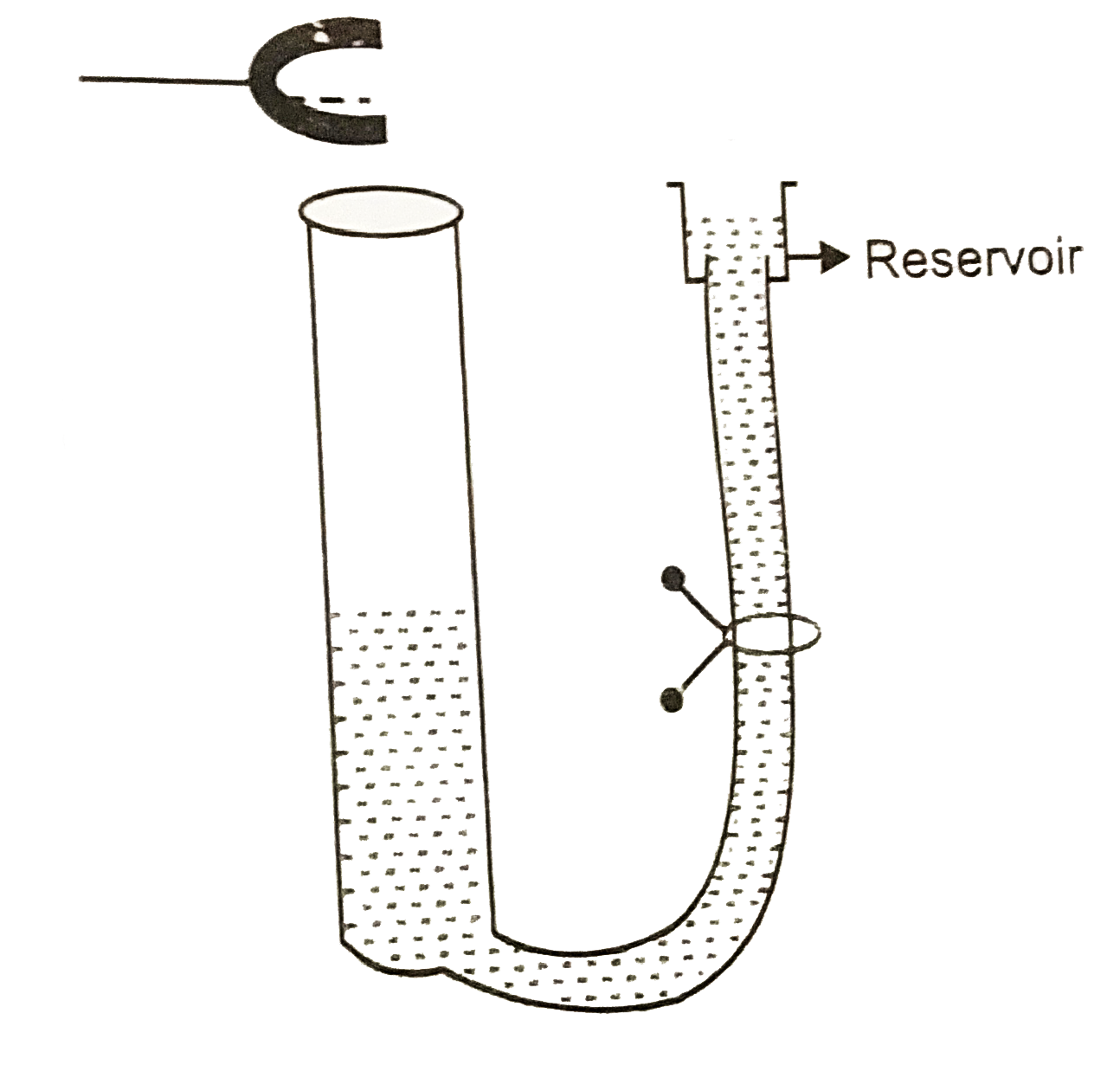A tuning fork vibrating with a frequency of 512 Hz is kept close to the open end of a tube filled with water , figure. The water level in the tube is gradually lowerd. When the water level is 17cm below the open end, maximum intensity of sound in heard. If the room temperature is 20∘C, calculate
(a) speed of sound in air at room temperature.
(b) speed of sound in air at 0∘C
(c) if the water in the tube is replaced with mercury, will there be any difference in your observations?

Consider the diagram frequency of tuning v=512 Hz.

For observation of first maxima of intensity
(a) L=λ4⇒=4L
v=vλ=512×4×17×10−2
=384.16m/s
(b) We know that v∝√T
where temperature (T) is in kelvin.
v20v0=√273+20273+0=√293273
v20v0√1.073=1.03
v0=v201.03=384.161.03=338m/s
(c) Resonance will be observed at 17 cm length of air column, only intensity of sound heard may be greater due to more complete reflection of the sound waves at the mercury surface because mercury is more danser than water.
Topper's Solved these Questions
- WAVESBOOK - NCERT EXEMPLAR ENGLISHCHAPTER - WAVESEXERCISE - LONG ANSWER TYPE QUESTIONS
5 Videos
- WAVESBOOK - NCERT EXEMPLAR ENGLISHCHAPTER - WAVESEXERCISE - VERY SHORT ANSWER TYPE QUESTIONS
7 Videos
- UNITS AND MEASUREMENTS BOOK - NCERT EXEMPLAR ENGLISHCHAPTER - UNITS AND MEASUREMENTS EXERCISE - Long Answer Type Questions
9 Videos
- WORK, ENERGY AND POWERBOOK - NCERT EXEMPLAR ENGLISHCHAPTER - WORK, ENERGY AND POWEREXERCISE - Long answer
1 Video
Similar Questions
A vibrating tuning fork is placed over the mouth of a burette filled with water. The tap is opened and the water level gradually falls.
What do you observe ? Name the phenomenon. When does it happen?
View SolutionAn excited tuning fork of frequency 512 Hz is held over the open end of a tall jar and water is slowly poured into it. Resonance was first observed at a level and then at a higher level. Calculate the difference in heights of the two levels. Velocity of sound in air at the time of experiment is 346 m/s.
View Solution
Knowledge Check
A tuning fork vibrating with a frequency of 500 Hz is kept close to the open end of a tube filled with water, as shown in figure. The water level in the tube is gradually lowered When the water level is 17 cm below the open to open end, maximum intensity of sound is heard. If the room temperature is 20∘ C, the speed of sound in air at the temperature is
 A1. 330ms−1B2. 340ms−1C3. 350ms−1D4. 360ms−1
A1. 330ms−1B2. 340ms−1C3. 350ms−1D4. 360ms−1Vibrating tuning fork of frequency n is placed near the open end of a long cylindrical tube. The tube has a side opening and is fitted with a movable reflecting piston. As the piston is moved through 8.75cm, the intensity of sound changes from a maximum to minimum. If the speed of sound is 350m/s. Then n is
 A500 HzB1000 HzC2000 HzD4000 Hz
A500 HzB1000 HzC2000 HzD4000 HzA tuning fork of frequency 440 Hz resonates with a tube closed at one end of length 18 cm and diameter 5 cm in fundamental mode. The velocity of sound in air is
A1. 336ms−1B2. 343ms−1C3. 300ms−1D4. 350ms−1
A tuning fork whose natural frequency is 440HZ is placed just above the open end of a tube that contains water. The water is slowly drained from the tube while the tuning fork remains in place and is kapt vibrating. The sound is found to be echanced when the air column is 60cm long and when it is 100cm long . Find the speed of sound in air.
View SolutionA tuning fork of frequency n is held near the open end of tube, the tube is adjusted until resonance occurs. If the two shortest lengths to produce resonance are L1andL2 , then the speed of the sound is
View SolutionThe lower end of a capillary tube is immersed in mercury. The level of mercury in the tube is found to be 2 cm below the outer level. If the same tube is immersed in water, up to what height will the water rise in the capillary ?
View SolutionA closed organ pipe can vibrate at a minimum frequency of 500 Hz. Find the length of the tube. Speed of sound in air =340ms−1.
View SolutionA tunning fork having a frequency of 170 Hz is vibrating just above a cylindrical tube. The height of the tube is 110 cm. Water is slowly poured in it. What is the minimum height (in cm) of water column required for resonance to occur? (Velocity of sound in air =340ms−1)
View Solution
